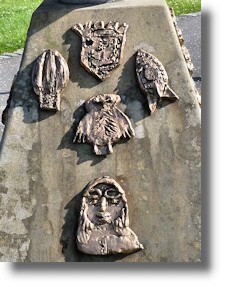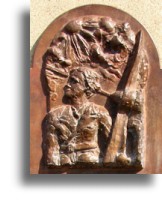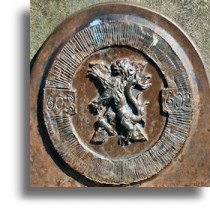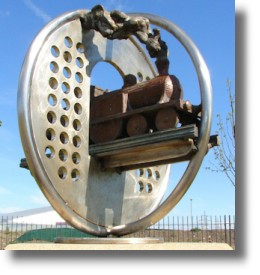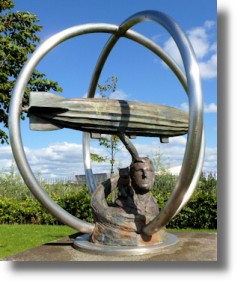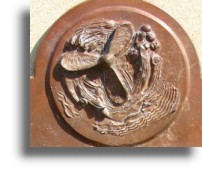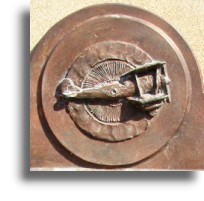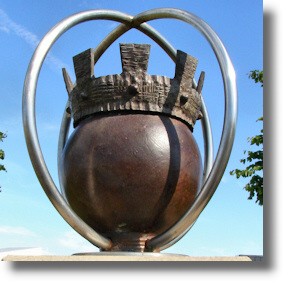Places to Visit in Scotland
- Clyde View Park, Renfrew
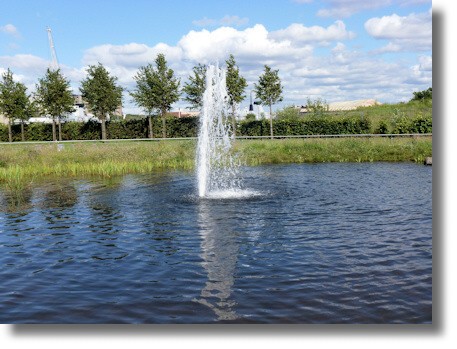
Background
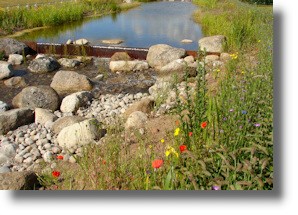
Clyde View Park in Renfrew is the first new park to be built in the West of Scotland for many years. It extends to 7 acres and features fountains, paths, cycleways, children's play areas, a tennis court, picnic areas, artwork and green space including an otter's holt and a riverside walkway. It has been designed to encourage natural wildlife, and flora and fauna. Its name "Clyde View" was chosen following a competition for local residents.
The park is part of the regeneration of the River Clyde from Braehead to Renfrew Town Centre which is transforming a total of 185 acres of brownfield land (previously occupied by the coal fired Braehead power station which was demolished in the early 1990s). Around 2000 homes are being built in the area along with other leisure facilities. A riverside walkway connects the huge Braehead retail park, the Xscape leisure centre and the Clyde View Park looking across the river to the shipyards on the northern bank of the river Clyde at Scotstoun.
Formally opened in June 2005, the park has a number of sculptures including a row of eight small models mounted on pedestals by artist Kenny Munro. They all have links to the history of the area with plaques attached to the pedestals providing historical details.
The Writers (Omega)
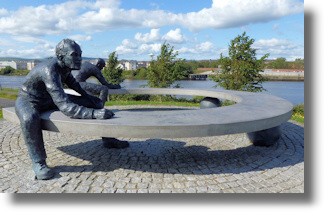
This striking sculpture is on top of a mound just inside the entrance at the riverside end of the park. It is by British sculptor David Annand.
Two writers, sit at opposite ends of a bench shaped like a horseshoe (or, more likely, a representation of Omega, the last letter in the Greek letter alphabet). The bench is resting on two spheres and is also supported by the legs of the writers. Many of Annand's sculptures have poems commissioned and engraved on them to engage the public and makes them take time with the piece. The inscription on top of this work, apparently written by the writers (but actually composed by Collete Bryce) is...
The future is waiting to be written
all weathers we lean to the task
the sky balanced on our shoulders like the past
Pyramid Stone
The Pyramid Stone is adorned with badges on the theme of birds, planes, boats and fish – natural and man-made voyagers of river, sea and sky and "celebrates the coexistence of manufacturing industry and creatures of the natural environment". Children from all five Renfrew Primary Schools – Moorpark, Newmains, Kirklandneuk, St James and Arkleston were all involved - assisted by artist Kenny Munro who has a reputation for innovative projects which celebrate cultural diversity and promote creative, collaborative ‘field-work’.
Pillars
There are eight pillars by Kenny Munro lining the side of the main path through the park. Each has a sculpture and information plaque, linked to the area’s history, enclosed in a stainless steel sphere. Much of the text below for each sculpture is based on these bronze information plaques.
Winifred J. Drinkwater
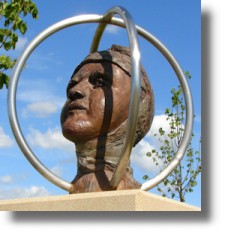
Winnie Drinkwater (1913-1996), became one of Scotland's youngest private aircraft pilots. She developed her passion as an aviatrix and aeronautical engineering with the Midland and Scottish Air Ferries Company. She achieved her “B” licence at the age of 19, making her probably the youngest female commercial pilot in the world. The small graphic on the right is from the information plaque and depicts her ready to crank one of the propellers of a three engined Airspeed Ferry which she piloted.Among her many achievements she won the Mobil Oil Cup in 1931 and the Guild of Air Pilot's Instructors Certificate. Shortly after completing her training she flew what was perhaps the first commercial day return service between Glasgow and London in 1934. After a whirlwind romance she married Francis Short, a director of Shorts, the flying-boat builders, in July 1934.
602 (City of Glasgow) Squadron, Royal Auxiliary Air force
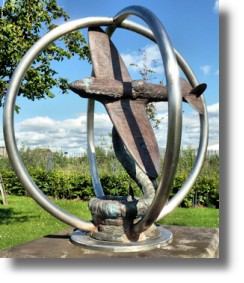
602 (City of Glasgow) Squadron, Royal Auxiliary Air Force was initially based at Moorpark Aerodrome, Renfrew. Moorpark played an essential role in the early days of civilian and military aviation in the west of Scotland and also as a training facility and as a base during both world wars.602 Squadron was formed on 12 September 1925 at Renfrew as a day bomber unit of the Royal Auxiliary Air Force. In 1939 it became a fighter squadron and was re-equipped with Supermarine Spitfires. At the start of WWII it was initially engaged in intercepting raids by the German Luftwaffe. But it had moved south by August 1940 and so participated in the Battle of Britain which resulted in Hitler abandoning the project to invade the United Kingdom. In 1946, 602 squadron reformed as a fighter squadron of the Auxiliary Air Force on 11 June, initially equipped with Spitfires. The unit assembled at Abbotsinch airfield near Paisley, the site of the present Glasgow International Airport.
Babcock and Wilcox Engineering
Babcock was established in 1881 as boiler makers, opening a factory in Renfrew in 1895.For over a century steam was relied upon to provide power for ships, cranes, workshops and all manner of machinery. The steam train presents a strong icon for energy, durability and determination.
Babcock and Wilcox designed and manufactured an enormous range of engineering equipment including nuclear power stations and machine salvage apparatus for raising the sailing ship Mary Rose, a warship of the English Tudor navy of King Henry VIII. She saw her last action on 19 July 1545. While leading the attack on the galleys of a French invasion fleet, she sank in the Solent, the straits north of the Isle of Wight. The wreck of the Mary Rose was rediscovered in 1971 and salvaged in 1982 by the Mary Rose Trust in one of the most complex and expensive projects in the history of maritime archaeology.
Howden Engineering, also in Renfrew, specialised in tunnel boring equipment which included supplying machinery for excavating the Channel Tunnel rail link between Britain and France.
Airship R34 and India Rubber Company
Airship R34 was built at Inchinnan in Renfrewshire in 1919. It was one of a series of hydrogen filled balloons supported by an innovative, lightweight internal, duralumin structure. R34 first flew on 14 March 1919 and was delivered to her service base at East Fortune near Edinburgh on 30 May of the same year. R34 made her first endurance trip of 56 hours over the Baltic on the 17 to 20 June. After the end of WWI, although it had never been intended as a passenger carrier, extra accommodation was arranged by slinging hammocks in the keel walkway while hot food was provided by cooking on a plate welded to the engine exhaust pipe! R34, became the first aircraft to make an East-to-West crossing of the Atlantic Ocean on 2 July 1919 and arrived at Mineola, Long Island, United States on 6 July after a flight of 108 hours with virtually no fuel left. As the landing party in the US had no experience of handling large rigid airships, Major EM Pritchard jumped by parachute and so became the first person to reach American soil by air from Europe. This was the first East-West crossing of the Atlantic and was done two weeks after the Transatlantic flight of Alcock and Brown in a modified World War I Vickers Vimy bomber. Also on board R34 was the first airborne stowaway, William Bannatyne from Newcastle (plus his cat, Whoopsie!). Bannatyne had been one of the crew members scheduled to stay behind to save weight but made the journey anyway! The return journey to Pulham in Norfolk was from 10 to 13 July and took 75 hoursFollowing several disastrous airship crashes by other airships, and the growth of the aircraft industry, production of airships ended.
A company making a range of rubber products occupied the original airship factories at Inchinnan from 1927 to 1981. The India Rubber Company made vehicle tyres and other products and undertook a major role during World War II (1939-1945)
Simons and Lobnitz Dredgers

Two shipyards at Renfrew were often referred to as the "home of steam dredgers". Coulburn Lobnitz and Company was established in 1874, and the adjacent shipyard of Simons was established in 1860. Both specialised in the construction of dredgers and hopper barges. The two yards were at the forefront of international dredging technology in the 19th century. Lobnitz in particular was a company with a distinguished history including the invention of the "Lobnitz Wheel" which improved dredging depth. The two companies eventually amalgamated in 1957 as Simons and Lobnitz. In the face of declining business the Renfrew yard finally closed in 1964, after some 1300 dredgers as well as barges and tugs had been built at the site.The development of shipbuilding and maritime trade would have been impossible without the work of dredgers. That was particularly true of the river Clyde which initially was a shallow river but became navigable all the way to the centre of Glasgow as a result of the work of dredgers.
The sculpture was inspired by an early vessel built on the Clyde in 1865.
Beardmore Engineering
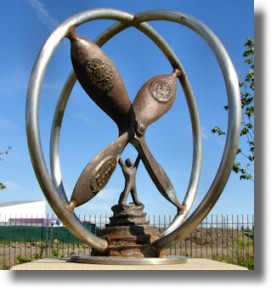
The sculpture here represents the energy in the community which harnessed the elements and forces of nature (the words air, fire, earth, water are carved on the propeller blades) to propel industrial innovation and skills. Development of engine technology was quickly exploited for the creation of paddle steamers which accelerated global exploration , followed by propeller driven ships and finely crafted aeroplanes in wood, canvas and metal.William Beardmore and Company was an engineering and shipbuilding conglomerate based in Glasgow and the surrounding Clydeside area. It was active between about 1890 and 1930 and at its peak employed about 40,000 people. It was founded and owned by William Beardmore, later Lord Invernairn, after whom was named the Beardmore Glacier in Antarctica, one of the largest glaciers in the world. By 1896 the works covered an area of 25 acres (100,000 square metres) and was the largest steelworks in Scotland, specialising in the manufacture of steel forgings for the shipbuilding industry of the River Clyde.
The local factory of Beardmore's made a series of biplanes during the first world war. This included the Sopwith "Pup" which was particularly successful as its folding wings enabled deployment at sea on the earliest aircraft carriers. The company also built and ran the Inchinnan Airship Constructional Station at Inchinnan in Renfrewshire. It produced the airships R27, R32, R34 and R36.
St Conval and Somerled
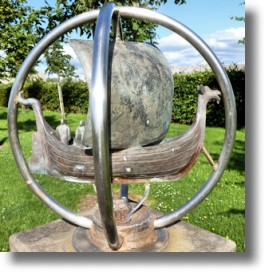
St Conval was one of the major founders of monasticism in the British Isles. According to legend, he was a son of an Irish prince and a spiritual student of Saint Kentigern (St Mungo) who became patron saint of Glasgow. One day as he stood on the edge of the Irish sea he asked for God‘s guidance for his life. The stone on which he was standing broke loose and carried him to Inchinnan where a chapel stands to commemorate the event. In the 10th century, 300 years after his death, Irish monks based at Inchinnan in Renfrewshire founded a series of churches in his name on the south bank of the river Clyde. These churches form the basis of the parishes that we know today.
Somerled, the Lord of the Isles, was initially the Regulus, or King, of Kintyre. His name is a common one amongst the Vikings who had over-run the Northern and Western Isles of Scotland and the Isle of Man. In 1153 two kings, David I of Scotland and Olaf of Mann both died. There was much confusion and discord as a result and Somerled took his chance, making offensive moves against both Scotland and Mann and the Isle of Man. Somerled landed at Renfrew in 1164 during a campaign aimed at asserting his authority over the seaways off the west coast of Scotland. A local force attacked his men from behind a smokescreen and killed him, bringing to an end Norse influence on the Clyde.
Royal Burgh of Renfrew
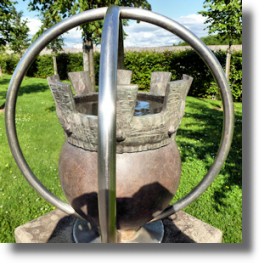
The bronze sphere and crown of this sculpture representing the Royal Burgh of Renfrew marks the importance of the Stewart monarchy and their connections with King's Inch, Renfrew.The royal coat of arms of the Stewarts recalls that the Burgh of Renfrew was granted to Walter FitzAlan, whose descendants became High Stewards of Scotland and later founded the Stewart dynasty that governed Scotland for over 400 years.
The Latin motto on the coat of arms is "Deus Gubernat Navem" which translates as "God steers the ship".
How To Get There
Clyde View Park is near the Braehead Shopping Centre in Renfrew, off King's Inch Road. There are frequent bus services direct to Braehead from many locations including Glasgow city centre, Paisley, Renfrew, Erskine and Glasgow Airport - see Transport Direct. Braehead can easily be reached by road from the whole of central Scotland and beyond and there are over 6500 free parking spaces so it's a quick and convenient place to visit. Braehead is signposted at junction 26 (eastbound) and junction 25a (westbound) of Glasgow's M8 motorway. There is a riverside walkway from Braehead that goes directly to the park. See also the Location Map (you can enlarge the scale of this map, if required).
